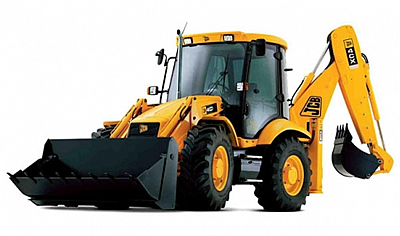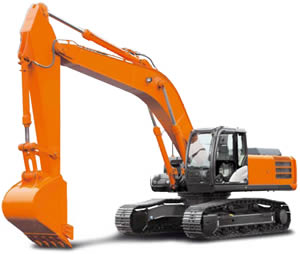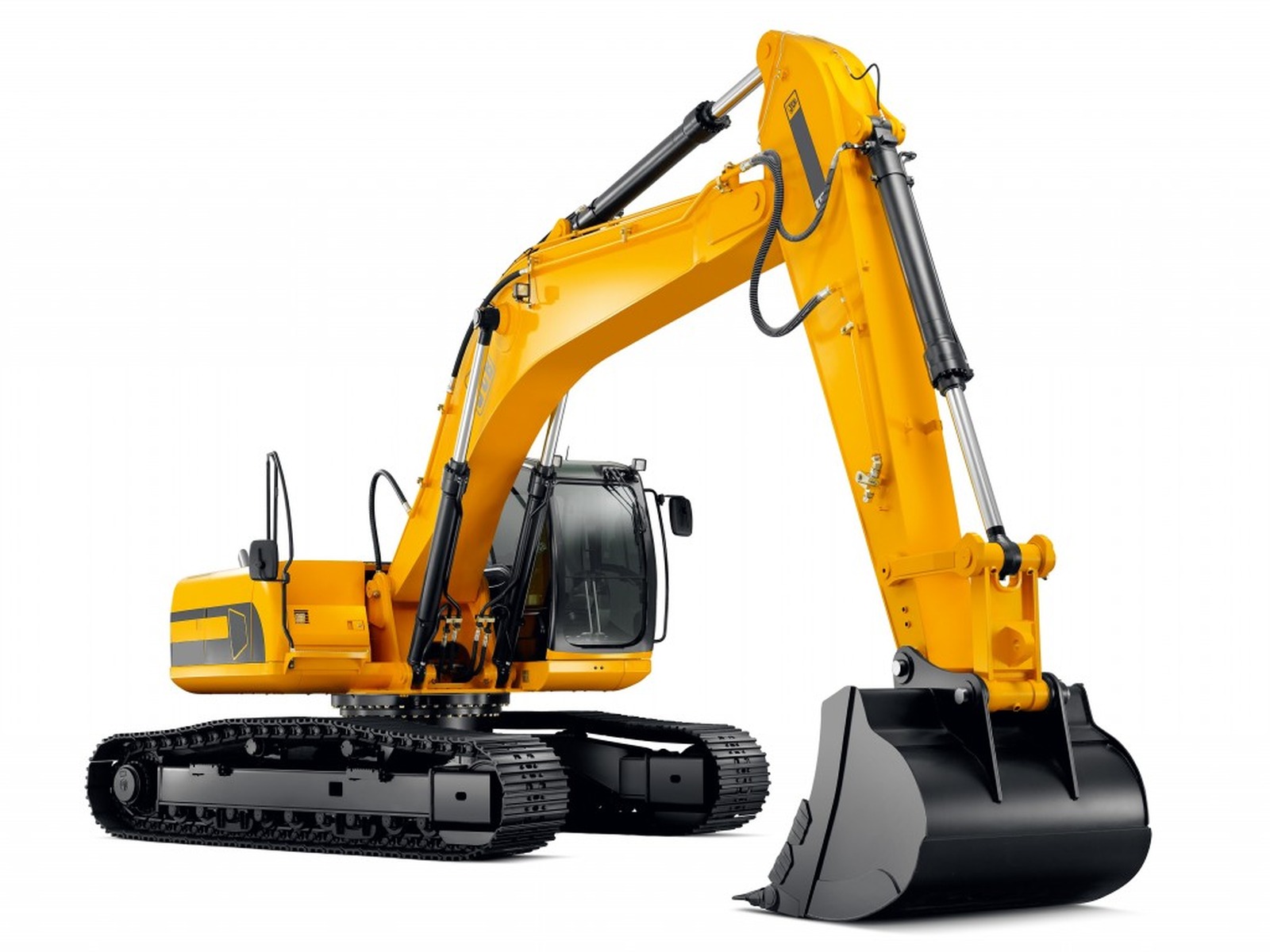Modern, hydraulic excavators come in a wide variety of sizes. The smaller ones are called mini or compact excavators. For example, Caterpillar's smallest mini-excavator weighs 2,060 pounds (930 kg) and has 13 hp; their largest model is the largest excavator available (a record previously held by the Orenstein & Koppel RH400) the CAT 6090, it weighs in excess of 2,160,510 pounds (979,990 kg), has 4500 hp and has a bucket size of around 52.0 m³ depending on bucket fitted.
Engines in hydraulic excavators usually just drive hydraulic pumps; there are usually 3 pumps: the two main pumps are for supplying oil at high pressure (up to 5000 psi) for the arms, swing motor, track motors, and accessories, and the third is a lower pressure (700 psi) pump for Pilot Control, this circuit used for the control of the spool valves, this allows for a reduced effort required when operating the controls.
The two main sections of an excavator are the undercarriage and the house. The undercarriage includes the blade (if fitted), tracks, track frame, and final drives, which have a hydraulic motor and gearing providing the drive to the individual tracks, and the house includes the operator cab, counterweight, engine, fuel and hydraulic oil tanks. The house attaches to the undercarriage by way of a centre pin. High pressure oil is supplied to the tracks' hydraulic motors through a hydraulic swivel at the axis of the pin, allowing the machine to slew 360° unhindered.
The main boom attaches to the house, and can be one of several different configurations:
Most are mono booms: these have no movement apart from straight up and down.
Some others have a knuckle boom which can also move left and right in line with the machine.
Another option is a hinge at the base of the boom allowing it to hydraulically pivot up to 180° independent to the house; however, this is generally available only to compact excavators.
There are also triple-articulated booms (TAB).
Attached to the end of the boom is the stick (or dipper arm). The stick provides the digging force needed to pull the bucket through the ground. The stick length is optional depending whether reach (longer stick) or break-out power (shorter stick) is required.
On the end of the stick is usually a bucket. A wide, large capacity (mud) bucket with a straight cutting edge is used for clean-up and levelling or where the material to be dug is soft, and teeth are not required. A general purpose (GP) bucket is generally smaller, stronger, and has hardened side cutters and teeth used to break through hard ground and rocks. Buckets have numerous shapes and sizes for various applications. There are also many other attachments which are available to be attached to the excavator for boring, ripping, crushing, cutting, lifting, etc.
Before the 1990s, all excavators had a long or conventional counterweight that hung off the rear of the machine to provide more digging force and lifting capacity. This became a nuisance when working in confined areas. In 1993 Yammer launched the world's first Zero Tail Swing excavator, which allows the counterweight to stay inside the width of the tracks as it slews, thus being safer and more user friendly when used in a confined space. This type of machine is now widely used throughout the world.
There are two main types of "Control" configuration generally use in excavators to control the boom and bucket, both of which spread the four main digging controls between two x-y joysticks. This allows a skilled operator to control all four functions simultaneously. The most popular configuration in the US is the SAE controls configuration while in other parts of the world, the ISO control configuration is more common. Some manufacturers such as Takeuchi have switches that allow the operator to select which control configuration to use.
Hydraulic excavator capabilities have expanded far beyond excavation tasks with buckets. With the advent of hydraulic-powered attachments such as a breaker, a grapple or an auger, the excavator is frequently used in many applications other than excavation. Many excavators feature a quick coupler for simplified attachment mounting, increasing the machine's utilization on the jobsite. Excavators are usually employed together with loaders and bulldozers. Most wheeled, compact and some medium-sized (11 to 18-tonne) excavators have a backfill (or dozer) blade. This is a horizontal bulldozer-like blade attached to the undercarriage and is used for levelling and pushing removed material back into a hole.
Bobcat Company
Bucyrus International
Case CE
Caterpillar Inc.
CNH Global
Doosan Infracore (formerly Daewoo Heavy Industries & Machinery) - including Solar brand
ENMTP
Hitachi Construction Machinery
Hydrema
Hyundai Heavy Industries
John Deere
J. C. Bamford (JCB)
Kanga Loaders
Komatsu Limited
LBX (Link-Belt) Excavators
ThyssenKrupp
Kobelco
Kubota
Liebherr
LiuGong
L&T
Mitsubishi Heavy Industries
New Holland
Orenstein and Koppel (O&K)
Poclain
Samsung Group
Sandvik Mining and Construction
Sany
ST Kinetics
Terex Corporation
Volvo Construction Equipment
Wacker Neuson
XCMG
Yanmar


